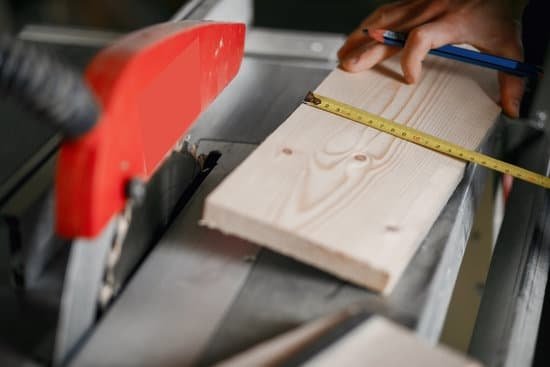Woodworking is a fulfilling hobby and craft that allows individuals to create functional and beautiful pieces from wood. However, not everyone has the luxury of owning a dedicated woodworking shop. Whether due to space constraints, budget limitations, or simply a nomadic lifestyle, there are challenges to overcome when attempting to practice woodworking without a traditional shop setup.
When it comes to how to do woodworking without a shop, one must be resourceful and adaptable. Without the convenience of a fully-equipped workshop, woodworkers must rely on handheld tools and portable equipment to bring their projects to life. This article will explore essential tools for woodworking without a shop, as well as tips on selecting the right workspace, maximizing storage space, and ensuring safety while working in unconventional settings.
While the lack of a traditional workshop may pose obstacles, many woodworkers have found innovative ways to pursue their passion for woodworking outside of a designated space. By exploring creative techniques, portable workbench options, and inspirational success stories from fellow woodworkers who have mastered the art of mobile woodworking, you too can embark on woodworking projects wherever your creativity takes you.
Essential Tools for Woodworking Without a Shop
Woodworking without a dedicated shop may seem like a daunting task, but with the right tools and equipment, it is definitely possible to create beautiful pieces even in unconventional spaces. One of the key elements to consider when embarking on woodworking without a shop is having the essential handheld tools that are necessary for various tasks. These tools not only provide mobility and flexibility but also allow woodworkers to work efficiently regardless of their workspace limitations.
Some of the essential handheld tools for woodworking without a shop include a quality hammer, chisels, hand saws, clamps, measuring tape, marking tools, hand planes, and screwdrivers. These tools are versatile and can be easily packed up and transported to different locations making them ideal for mobile woodworking. Investing in high-quality handheld tools is crucial as they will make your woodworking experience more enjoyable and successful.
When figuring out how to do woodworking without a shop, having the right equipment can make all the difference. Portable power tools such as cordless drills, jigsaws, sanders, and routers can also be incredibly useful for those working in limited spaces.
Additionally, accessories like a sturdy tool belt or apron can keep your essential tools within reach at all times. By having a well-rounded collection of both handheld and power tools, you can effectively tackle various woodworking projects no matter where you are working from.
Choosing the Right Workspace
When it comes to woodworking without a shop, one of the key aspects to consider is selecting the right workspace. While you may not have a dedicated shop, choosing a suitable area for your woodworking projects is crucial for efficiency and safety. Here are some tips on how to set up your workspace for successful woodworking:
1. Natural Light: Look for a space with ample natural light to help you see your work clearly. If possible, position your workspace near a window or use task lighting to brighten up the area.
2. Ventilation: Ensure good ventilation in your workspace to avoid inhaling harmful fumes from wood stains, finishes, and dust particles. If working indoors, consider setting up a fan or opening windows for proper air circulation.
3. Sturdy Surfaces: Opt for sturdy surfaces like countertops or tables that can withstand the weight of your tools and materials. Make sure the surface is level to provide stability while working on your projects.
4. Organization: Keep your workspace well-organized by using storage solutions such as shelving units, pegboards, or toolboxes to store your tools and materials efficiently. This will not only save space but also make it easier to find what you need during woodworking sessions.
By following these tips on choosing the right workspace, you can create a conducive environment for woodworking even without a dedicated shop. Remember that the key is to adapt and be resourceful in making the most out of the space you have available for your projects.
Maximizing Storage Space
When it comes to woodworking without a shop, one of the biggest challenges is finding suitable storage solutions for tools and materials. Limited space means that organization becomes even more crucial to ensure efficiency and productivity in your projects. There are several creative ways to maximize storage space even in unconventional workspaces.
One effective storage solution is utilizing wall space for vertical storage. Installing pegboards, shelves, or magnetic strips on the walls can help free up valuable floor space while keeping tools within easy reach. Another option is using stackable bins or containers to store smaller items like screws, nails, and other accessories neatly tucked away when not in use.
In addition to wall storage, considering multi-functional furniture can also help optimize space. Workbenches with built-in storage drawers or cabinets provide a convenient way to keep tools organized while doubling as a workspace.
Furthermore, mobile tool carts or rolling cabinets offer flexibility by allowing you to move your tools around easily as needed. By thinking outside the box and getting creative with your storage solutions, you can effectively manage your woodworking tools and materials even without a dedicated shop.
| Storage Solution | Description |
|---|---|
| Vertical Wall Storage | Utilize pegboards, shelves, or magnetic strips on walls for efficient tool organization |
| Stackable Bins/Containers | Store small items neatly in bins or containers to save space |
| Multi-functional Furniture | Invest in workbenches with built-in storage or mobile tool carts for flexible organization |
Portable Workbench Options
Foldable Workbenches
When it comes to woodworking without a dedicated shop, having a portable workbench is essential. Foldable workbenches are a great option for those who need to set up and tear down their workspace frequently. These workbenches can be easily stored away when not in use and provide a sturdy surface for various woodworking tasks. Look for foldable workbenches that are lightweight yet durable to withstand the demands of woodworking on-the-go.
Clamp-on Workbenches
For woodworkers who prefer versatility and convenience, a clamp-on workbench is a practical solution. These workbenches can be attached to any sturdy surface, such as a table or countertop, allowing you to create a temporary workspace wherever you go. Clamp-on workbenches often come with built-in clamps or vises to secure your projects in place while you work. This option is ideal for those who have limited space but still want a reliable workbench for their woodworking projects.
Multi-Functional Workstations
To maximize efficiency in woodworking without a shop, consider investing in a multi-functional workstation that combines storage, organization, and workspace into one portable unit. These compact units typically include shelves, drawers, and a flat surface for working on your projects. Some even come with built-in power strips for plugging in tools and equipment. With a multi-functional workstation, you can have everything you need within arm’s reach, making it easier to tackle woodworking projects on-the-go.
Woodworking without a shop may present challenges, but with the right portable workbench options, you can still enjoy pursuing your craft wherever inspiration strikes. By choosing a foldable workbench, clamp-on workbench, or multi-functional workstation that suits your needs and space constraints, you can create a functional workspace for woodworking outside of a traditional shop setting. Remember to prioritize durability, stability, and ease of setup when selecting a portable workbench for your mobile woodworking adventures.
Safety Measures for Mobile Woodworking
Woodworking involves working with sharp tools, heavy machinery, and potentially hazardous materials. Ensuring safety is paramount, especially when working in unconventional spaces without a traditional workshop setup. Here are some key safety measures to consider when undertaking woodworking without a shop.
Personal Protective Equipment (PPE)
One of the most important aspects of woodworking safety is wearing the appropriate personal protective equipment (PPE). This includes safety glasses to protect your eyes from flying debris, hearing protection to guard against loud noise generated by power tools, gloves for hand protection, and a dust mask to prevent inhalation of wood particles and other harmful substances.
Proper Tool Usage
When working in a non-traditional woodworking space, it’s crucial to use tools properly and with caution. Ensure that all handheld tools are in good working condition and used according to manufacturer instructions. Keep blades sharp and clean for better performance and safety. Additionally, always maintain focus and avoid distractions when operating tools to prevent accidents.
Fire Safety
Woodworking often involves flammable materials such as sawdust, solvents, and finishes. When working in unconventional spaces like a makeshift workshop at home or outdoors, it’s essential to have fire safety precautions in place. Keep a fire extinguisher nearby, store flammable materials properly away from heat sources, and be mindful of potential fire hazards while working on projects.
By following these safety measures for mobile woodworking, you can minimize risks and create a safe environment for your woodworking projects even without a dedicated shop setup. Remember that prioritizing safety not only protects yourself but also ensures the quality of your workmanship in the long run.
Innovative Woodworking Techniques
For individuals looking to pursue woodworking without a traditional shop space, it may seem daunting at first. However, with the right techniques and mindset, it is entirely possible to create beautiful pieces even in unconventional settings. Here are some tips on how to do woodworking without a shop:
1. Utilize portable tools: Invest in handheld tools such as a hand saw, chisels, hammer, measuring tape, and clamps. These tools are essential for executing basic woodworking tasks even without a dedicated workshop.
2. Explore alternative workspaces: Look for areas in your home or outdoors that can serve as a makeshift workshop. It could be a patio, garage, balcony, or even a corner of your living room. Ensure the space has good lighting and ventilation for comfortable woodworking sessions.
3. Think outside the box: Get creative with your woodworking projects by using materials that are easily accessible and don’t require heavy machinery. Consider upcycling old furniture or using reclaimed wood for your projects. This not only adds character to your creations but also makes woodworking more sustainable.
By following these innovative woodworking techniques and thinking creatively about how to adapt to limited spaces, anyone can enjoy the art of woodworking without the need for a traditional shop setup. With determination and resourcefulness, you can embark on rewarding woodworking projects regardless of where you are located or what resources you have access to.
Success Stories
Woodworking without a proper shop may seem daunting at first, but with the right tools, workspace, and mindset, it is certainly possible to create beautiful pieces of craftsmanship. By understanding the essential tools needed for woodworking on-the-go and choosing the right workspace, individuals can embark on their woodworking journey no matter where they are. Creative storage solutions and portable workbench options also play a crucial role in making woodworking outside of a traditional shop setting feasible.
One key aspect of mastering woodworking without a shop is prioritizing safety measures. Whether you’re working in a small garage, backyard, or even a shared communal space, it is essential to follow safety guidelines to prevent accidents and injuries. Additionally, by exploring innovative woodworking techniques and thinking outside the box when faced with limitations, woodworkers can still achieve remarkable results in unconventional spaces.
Finally, success stories of woodworkers who have thrived in non-traditional settings serve as inspirational tales for those looking to pursue woodworking without a dedicated shop. These individuals have overcome challenges through determination, creativity, and adaptability. Their achievements showcase that with passion and perseverance, anyone can learn how to do woodworking without a shop and create truly remarkable pieces of art.
Frequently Asked Questions
How to Woodwork Without a Garage?
Woodworking without a garage can be challenging, but it’s definitely possible with some creativity and planning. Consider setting up a workbench in a spare room, basement, or outdoor space like a patio. Utilize portable tools and equipment that can easily be stored away when not in use.
Can You Learn Woodworking by Yourself?
Learning woodworking by yourself is absolutely achievable with the abundance of resources available today. Online tutorials, books, and instructional videos can provide you with the necessary knowledge and skills to get started. Practice, patience, and dedication are key to mastering this craft on your own.
Is Woodworking a Cheap Hobby?
Woodworking can be as inexpensive or costly as you make it depending on the tools, materials, and projects you choose. Starting with basic hand tools and scrap wood can keep costs low while still allowing for skill-building. As you progress, investing in quality tools and materials may increase expenses but can enhance the overall experience.

Hi everyone! I’m a woodworker and blogger, and this is my woodworking blog. In my blog, I share tips and tricks for woodworkers of all skill levels, as well as project ideas that you can try yourself.





